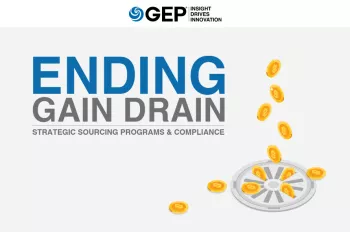Given persistent uncertainty in the economy, Chief Procurement Officers are being put on the hot seat at many global organizations, facing enormous pressure to reduce spend enterprise-wide and deliver increased savings year after year.
Given these pressures, some companies have been re-evaluating “Consortium-based Buying Models” (CBMs), hoping that this kind of group purchasing approach will help them achieve higher savings.
While creating and leveraging greater economies of scale is a sound principle, both our research and considerable experience — developed from sourcing more than $50 billion of spend for clients annually — has revealed time after time that group purchasing models do not maximize savings for large, global enterprises.
Make no mistake – CBMs can provide some organizations true value – namely small- and medium-sized enterprises (SMEs) and public sector agencies, where the economies of scales achieved are dramatic and decisionmaking is relatively simple.
However, at enterprises with revenues of more than $1 billion, the scale effects and actual savings achieved through CBMs are not only less impressive, but fail to deliver the realized savings of more individuated approaches.
The key is what we call “Implied Leverage” or “Economies of Knowledge.”
Challenges with Consortia-Based Buying Models
First, a definition — CBMs are effectively group purchasing organizations. They can range from local, not-for-profit buying collectives to large international for-profit purchasing organizations.
By pooling the collective spend of certain commodity goods and services, each member company can tap into the increased buying power and economies of scale that it is unlikely to achieve on its own.
In these scenarios, the consortium focuses on aggregating spend volumes by enrolling new members. Master Service Agreements are already negotiated with preferred suppliers, and member companies simply have to sign-on to this master contract to enjoy the preferred prices. Many consortia charge fees for these services and member companies may have certain spend commitments and other obligations.
However, it's a different story for larger enterprises. They do not reap the maximum benefit.
Why? The answer lies in the very nature of larger organizations — their size, structure, complexity and diverse stakeholders — that renders consortia both less effective and less desirable.
Limited-Scale Economies
Not every category of spend is sensitive to highscale effects. Much depends on the inherent cost structure of the category in question.
High-volume manufactured goods, such as paper and corrugated boxes, do see high-scale effects. In contrast, many service-based categories like legal services, creative agencies, temporary staffing and IT services see relatively little.
Since CBMs rely so heavily on economies of scale, they often miss significant savings opportunities by not addressing the main cost drivers for each category of spend.
Savings on legal services, for example, are more easily achieved by reducing hourly rates through competitive bidding, reallocating work based on lowest-cost-to-serve guidelines and exploring alternative fee arrangements, such as fixed-price billing or capped fees for certain routine activities.
Stakeholder Dissatisfaction
Leveraging total spend volumes across a large, complex enterprise is challenging in its own right. It requires a tremendous amount of skill, energy and effort to persuade the heads of different departments, business units and geographies to collaborate on sourcing to create savings for the enterprise overall.
Everyone has their own requirements and priorities, and everyone is very, very busy. Reaching consensus in such an environment is not easy, but it yields tremendous results. Yet, both to achieve buy-in and maximize actual value, factors such as quality or service level are at least as important as price per unit or its equivalent.
CBMs do not credibly address these value levers, let alone meet the often individuated needs, priorities and objectives of enterprises. Thus, it should be little surprise that compliance with CBM agreements – and savings achieved – is often quite low.
Case in point — printing. Persuading each and every executive with printing spend (i.e., executives across all corporate functions, business units and geographies) to collaborate on a joint sourcing effort is a Herculean task.
Getting these same executives to embrace a preexisting contract with an unknown vendor, over which they will have reduced control, is next to impossible. And frankly, that's not the best solution for the enterprise. The fact is that reduced control is a fundamental flaw with CBMs.
Reduced Control and Compliance
When joining a consortium, purchasers will usually see their control of vendor relationships degraded. Indeed, some procurement professionals question whether the purchaser — now mediated by a consortium — still has a bona fide “relationship” with the vendor or has, in effect, ceded the relationship to the consortium.
No matter how you look at it, each and every member company is now a smaller player within a larger deal. There is a distinct possibility that an individual buyer may not get the expected level of service, attention or responsiveness.
The channels of communication for vendor performance management are now more complicated and involve other companies. Few plant managers would be excited about a discount on their corrugated box purchases if it resulted in longer lead times, higher scrap rates and poor ontime delivery performance.
Getting the full, undivided and urgent attention of a vendor in a consortium can be far more challenging when you're just one of many companies.
Plant managers won't tolerate this for long within their own plant network. They won't tolerate it for a minute in a CBM arrangement. So we see more non-compliance to the CBM contract as executives 'go rogue' to fulfill their responsibilities and meet expectations. They have no problem striking side deals with suppliers that are fully responsible to them and their requirements.
What's more, to take full advantage of CBM deals, stakeholders across all functions, business units and geographies must be willing to cede control, not just of their vendor choices, but often of their base requirements.
They may have to modify their respective business processes or their underlying technologies to leverage the CBM deal.
In the case of enterprise software, stakeholders across entirely different (at times competing) companies will likely need to agree to a common technical platform, standard service levels, common approaches to data security and privacy, among other things. This is required, without regard to the individual business strategies, corporate culture or competitive nature of the consortium members.
Uniformity of this kind is challenging within a large enterprise. Extending this collaboration across unrelated companies is a bridge too far for most stakeholders.
Clearly, there are serious drawbacks with consortia buying for large enterprises. The good news is that there is a more effective approach, proven to achieve higher rates of realized savings without the show-stopping compromises.
GEP refers to this as “Implied Leverage.”
How Does Implied Leverage Work?
Large, global enterprises should achieve higher savings by effectively leveraging their group-level spend through robust strategic sourcing processes. This requires the understanding and use of all value-creation levers, rather than simply relying on volume aggregation savings in umbrella contracts.
These are the elements of “Economies of Knowledge.”
 Global Benchmarks
Global Benchmarks
Access to extensive pricing and supplier databases, aggregating data points across multiple companies, industries, geographies and spend categories. Knowing best-in-class pricing and understanding best value drivers so they can be applied to individual enterprise sourcing/negotiation initiatives.
 Category Expertise and Market Intelligence
Category Expertise and Market Intelligence
Ability to access real-time market intelligence as well as deep category expertise allows organizations to address all cost and savings drivers. For example, spare capacity in the market for ocean freight, and knowing that it exists in the right locations, can deliver far greater savings than economies of scale.
 Change Management
Change Management
Leveraging the skills to build consensus and cooperation across complex organizations and autonomous business units.
 Multidimensional Negotiations
Multidimensional Negotiations
Delivering additional savings and greater value from improved terms, better service, clear performance commitments, customized to each individual organization and key stakeholders.
The key benefits of approach are:
![]() Better pricing
Better pricing
![]() Increased compliance
Increased compliance
![]() Higher realized savings
Higher realized savings
![]() Greater comprehensive value equation *
Greater comprehensive value equation *
![]() Organization-specific solutions **
Organization-specific solutions **
![]() Accelerated time to value
Accelerated time to value
GEP relies on its extensive cadre of highly knowledgeable category experts who continually monitor and evaluate their markets, researching trends and reviewing price benchmarks gathered across a broad range of clients across various industries.
Through continual research and experience, the development of up-to-date supplier databases, pricing benchmarks and quality benchmarks, procurement service providers like GEP have a thorough understanding and knowledge of the spend category. As a result, negotiations with suppliers focus on a comprehensive value equation and ultimately drive maximized value in any supplier negotiation.
We've seen numerous examples where the realized savings from consortium buying were significantly lower than the savings realized in cross-enterprise strategic sourcing, using implied leverage.
This is true even in the case of office supplies, the quintessential commodity category. Think megavolumes brings higher savings on pens and paper? Think again.
* Inclusive of multiple factors, including cost reduction, quality, functionality, service level, delivery and payment terms, and other elements
** Customized sourcing driven by an organization's particular and very specific needs, geographic and market requirements, corporate and user preferences
 Case Study
Case Study
Implicit Leverage in Action
A leading telecommunications firm, a GEP client, with more than $5 billion in annual revenues weighed both a CBM and a strategic sourcing model with implied leverage, and compared results.
The category in review was office supplies. The Implied Leverage model won handily. How?
The CBM consolidated the spend of 20 individual companies, achieving a combined spend of eight times greater than the telecommunications firm alone. The CBM identified pro forma savings of 30 percent on select products. At first, this seemed like a great deal. These prices, however, were tied to strict spend limits.
The telecommunications firm was also required to switch suppliers and absorb all switching costs. And some of these savings were contingent on hitting annual volume levels that were out of the company's control – and had not been met in the previous year.
Still, in its initial stage, this was viewed as a great deal and it was indeed better than their original base line. But even better results were achieved through a strategic tendering process.
Here, GEP focused strictly on the client's very specific office supply requirements and the real contours of its spend. An experienced sourcing team led a robust competitive tendering process that evaluated multiple suppliers through multiple rounds of discussion and negotiations.
This resulted in prices that were 2–5 percent lower than the CBM for the client’s specific SKUs.
Furthermore, these savings came from their incumbent supplier, eliminating all switching costs or operational risks associated with changing vendors.
Additionally, the incumbent supplier agreed to even higher savings on specific paper and toner products not covered in the CBM but quite important to the client.
Furthermore, the sourcing efforts provided even greater value through a volume-based rebate structure that was tied solely to the client's historic volumes, and thus, were far more in the client's control and more likely to be achieved than those in the CBM deal.
Lastly, the sourcing effort led to better payment terms than the CBM, as well as a $100,000 retention bonus paid directly to the client to seal the deal.
Let's re-cap what was achieved through 'Implied Leverage'. By focusing on the client's specific realworld requirements, and by leveraging deep market knowledge and strong price benchmarks, GEP achieved lower prices, better terms, with less risk, no costs and immediate cash flow benefits.
That, we submit, in dollars and cents is the power of rigorous strategic sourcing and 'Implied Leverage' provided by an expert procurement services provider.
Consider Reality
Consortia-based buying models can deliver significant savings benefits to small- and mid-sized companies. But large, global companies simply do not achieve the same gains. Non-compliance is endemic and creates enormous gaps between contracted and realized savings. Moreover, the inherent awkward nature of CBMs brings often unacceptable limitations on business agility and competitiveness.
In fact, CBMs foist a hornet's nest of strategic, operational and competitive issues onto large, global enterprises. What makes these potentially self-inflicted wounds worse is that they are entirely unnecessary.
Procurement services providers provide the surest route not only to the best price but also the best value.
Industry, category and market expertise, state-ofart tools and technology, relationships, resources, reputation, skilled staff on demand and at scale, optimized work process and proven methodologies — these are just some of the assets that enable procurement service providers to leverage the spend of large enterprise clients in the most efficient, effective ways possible.
Working with a procurement service provider, a large enterprise will realize both higher savings and best value. Without loss of visibility, relationship, understanding or control. Without sacrificing the confidence and satisfaction of internal clients. And without resignation to abysmal rates of compliance that render the consortium purchasing agreement functionally irrelevant.
Theme: Software and Technology



